Spotting tiny, buzzing insects around your fruit bowl or kitchen sink? You’ve likely encountered fruit flies. These common household pests can be a nuisance, but thankfully, eliminating them is easier than you might think. You don’t need fancy gadgets or harsh chemicals – simple, do-it-yourself (DIY) methods using everyday items you probably already have at home are incredibly effective.
Having recently dealt with a fruit fly invasion in my own kitchen, I decided to put various removal techniques to the test. After thorough experimentation and careful observation, I’m sharing the best homemade fruit fly traps and practical prevention strategies to help you reclaim your kitchen. These traps are not only easy to assemble but also utilize natural, readily available ingredients. For those who prefer a humane approach, these methods even offer the option to release the trapped flies outdoors.
Understanding Fruit Flies: Identification and Why They’re a Problem
Fruit flies, aptly named, are small flying insects that are strongly attracted to ripe and fermenting fruits and vegetables. Their keen sense of smell also draws them to sugary drinks like juice, beer, and wine, as well as decaying organic matter in garbage disposals and trash cans. You’ll often find them congregating around fruit bowls, garbage bins, and even drains in your kitchen. Physically, they are minute – about the size of a grain of rice – and resemble small houseflies, typically tan or brownish with distinctive red eyes. Fruit flies are most prevalent during warmer months, particularly summer and late fall, when fruits are abundant.
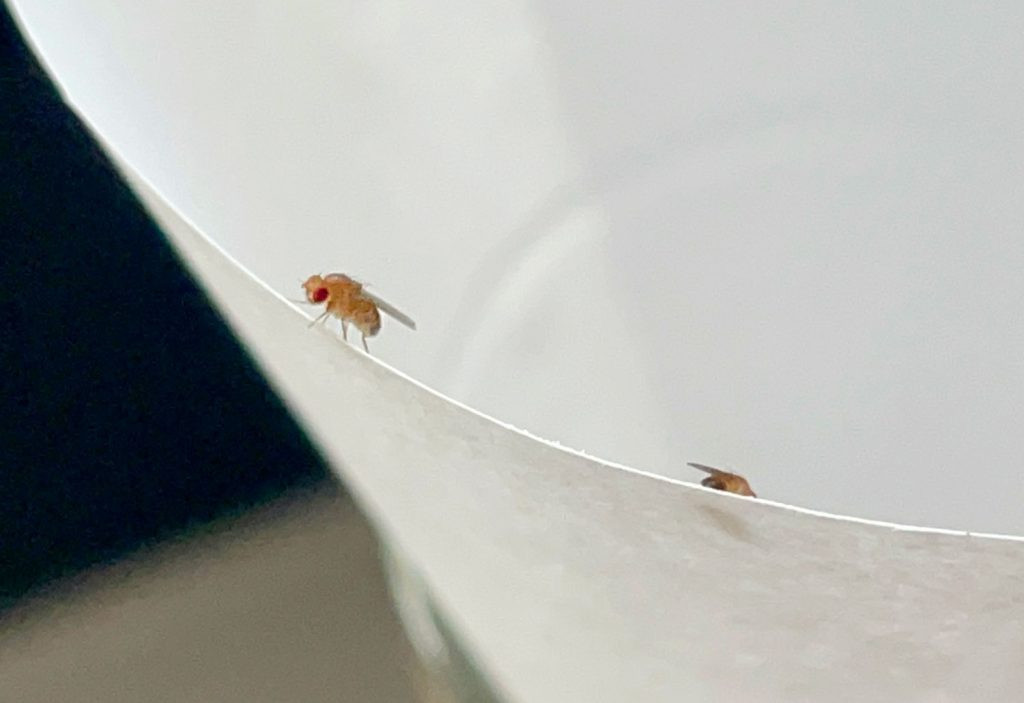 Close Up Of Fruit Fly On Paper Funnel
Close Up Of Fruit Fly On Paper Funnel
Alt text: Detailed close-up of a fruit fly with red eyes perched on the edge of a paper funnel, illustrating the common kitchen pest.
A fruit fly infestation often begins subtly, perhaps with just a few individuals hitching a ride into your home on fresh produce. However, their rapid breeding cycle is what quickly turns a minor issue into a major swarm. Female fruit flies can lay hundreds of eggs in their short lifespan, and these eggs can hatch in as little as 24 hours. They mature into adults within days, meaning a small initial presence can explode into a large population in a very short time. This rapid reproduction is why swift action is crucial to get rid of fruit flies as soon as you spot them.
Fruit Flies vs. Fungus Gnats vs. Drain Flies
It’s easy to mistake fruit flies for other small flying insects commonly found indoors, especially fungus gnats and drain flies. While all are small and can be annoying, correctly identifying the pest is key to choosing the most effective elimination method. The easiest way to differentiate them is by observing where you see them and what larger insect they resemble.
- Fruit flies look like small flies. As mentioned, they are typically found buzzing around fruit bowls, trash cans, or any exposed food source.
- Drain flies look like small fuzzy moths. You’ll usually spot them near sinks, drains, and damp areas.
- Fungus gnats look like small mosquitos. These pests are commonly found around houseplants, as they breed in moist potting soil.
If you’re unsure which pest you’re dealing with, try one of the fruit fly traps detailed below. If it attracts the insects in your home, you’ve confirmed you have fruit flies!
Effective DIY Fruit Fly Traps You Can Make at Home
Getting rid of fruit flies doesn’t have to be a complicated or expensive undertaking. The core principle of any effective fruit fly trap is simple: attract the fruit flies and then prevent their escape. You can create several highly effective traps using common household items. I tested four different DIY methods, and while all showed results, a clear winner emerged. Since each trap uses items you likely already have, experimenting with a few different types is easy and worthwhile. Consider it a fun, mini-science experiment in your kitchen! Here are four simple DIY fruit fly trap methods:
- Funnel Trap
- Plastic Wrap Trap
- Dish Soap Trap
- Rotting Fruit Trap
Let’s explore each of these homemade traps in detail, along with step-by-step instructions and insights into their effectiveness. Keep in mind that some traps work faster than others, and complete eradication may take a few days, regardless of the technique.
#1: Funnel Fruit Fly Trap
This trap design lures fruit flies into a container using a paper funnel with a narrow opening at the bottom. The flies are attracted to the bait and enter easily but struggle to navigate their way back out through the small opening.
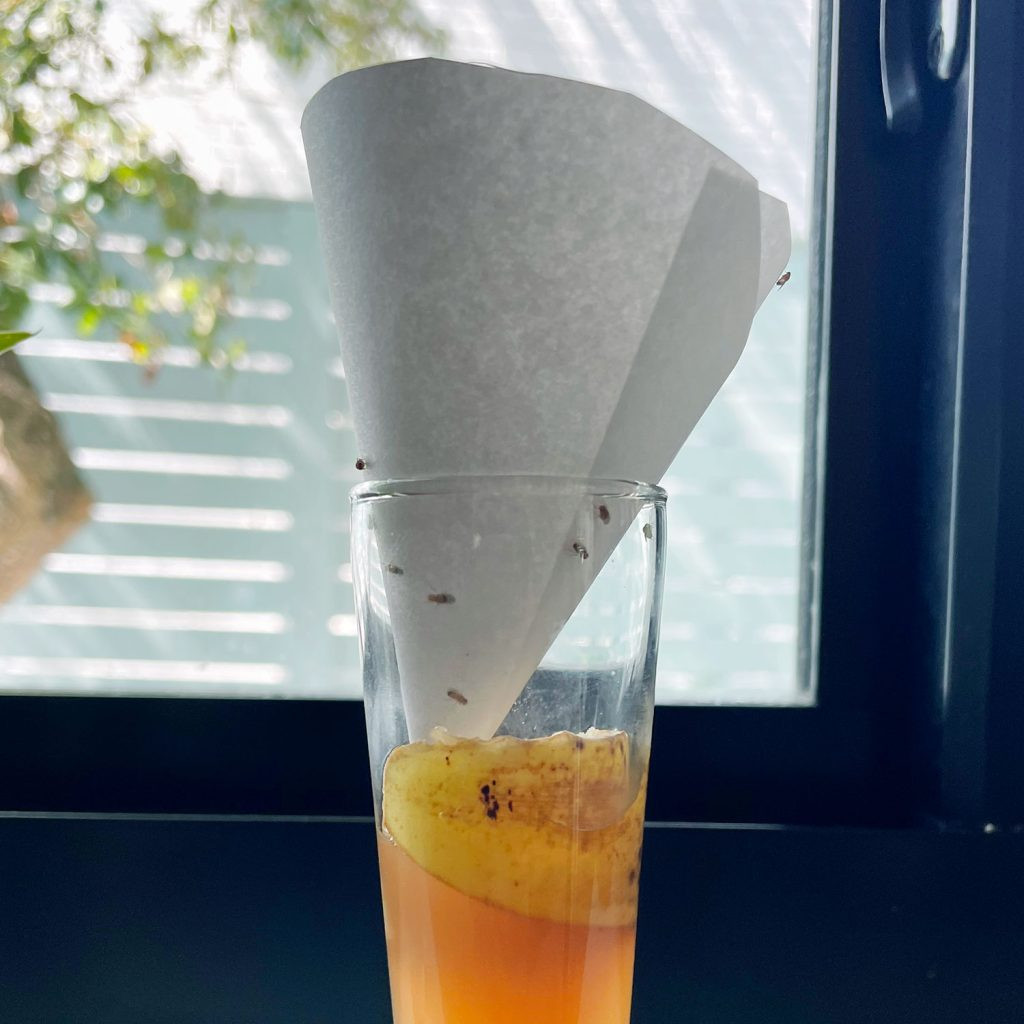 DIY Fruit Fly Trap With Paper Funnel
DIY Fruit Fly Trap With Paper Funnel
Alt text: A homemade fruit fly funnel trap, showcasing a paper funnel inserted into a glass jar with apple cider vinegar at the bottom, a simple and effective design.
Supplies needed:
- Small clear jar, cup, or container (narrow opening preferred)
- Piece of paper or cardstock
- Tape
- Scissors
- Apple cider vinegar (ACV)
Instructions:
- Choose your container. Select a small, clear container like a clean food jar or a plastic bottle. A narrow opening helps improve the trap’s efficiency.
- Add apple cider vinegar. Pour a small amount of apple cider vinegar, old beer, or wine into the bottom of the container. These liquids are potent attractants for fruit flies.
- Make your funnel. Shape a piece of paper or cardstock into a cone with a very small hole at the pointed end. Secure the cone shape with tape. You can create the small opening by cutting the tip of the cone if easier. The hole only needs to be about the size of a grain of rice.
- Set your funnel. Place the paper funnel into the container’s opening. Adjust the funnel so it sits securely on the rim without touching the liquid bait. Ensure there are no gaps around the funnel’s edge where flies could escape.
- Optional humane release. To release captured flies outdoors, carefully carry the trap outside without disturbing the funnel. Remove the funnel outdoors to allow the flies to escape.
While you can use a store-bought funnel, the opening at the bottom might be too wide, allowing trapped fruit flies to escape more easily. A homemade paper funnel allows for a more precisely sized, smaller opening.
#2: Plastic Wrap Fruit Fly Trap
Similar to the funnel trap, the plastic wrap trap uses apple cider vinegar to attract fruit flies. Flies enter through small holes poked in a plastic wrap cover but then have difficulty escaping.
Supplies needed:
- Small clear jar, cup, or container
- Rubber band
- Plastic wrap or plastic bag
- Toothpick
- Apple cider vinegar (ACV)
Instructions:
- Choose your container. Select a small, clear jar, cup, or glass container. Clarity helps you monitor the trap’s success. An old can also works.
- Add apple cider vinegar. Pour apple cider vinegar into the container. Its enticing scent is crucial for attracting fruit flies. Old beer or wine can also be used, but avoid white vinegar, which is less effective.
- Cover with plastic wrap. Tightly stretch plastic wrap over the container opening and secure it with a rubber band to create an airtight seal. You can use standard kitchen plastic wrap or cut a piece from a plastic bag.
- Poke small holes. Use a toothpick to carefully poke a few small holes in the plastic wrap top. The holes should be just large enough for fruit flies to enter.
- Optional humane release. To release trapped flies, carefully transport the trap outdoors without removing the plastic wrap. Remove the plastic wrap cover outside to let the flies fly away.
Alternatively, you can adapt this method using a jar with a metal lid. Puncture a small hole in the lid using a hammer and nail instead of using plastic wrap.
#3: Dish Soap Fruit Fly Trap
This trap differs from the previous two by not requiring a cover. Instead, it uses a soapy surface to trap fruit flies. Note: Flies trapped in this method will be coated in soap and cannot be released.
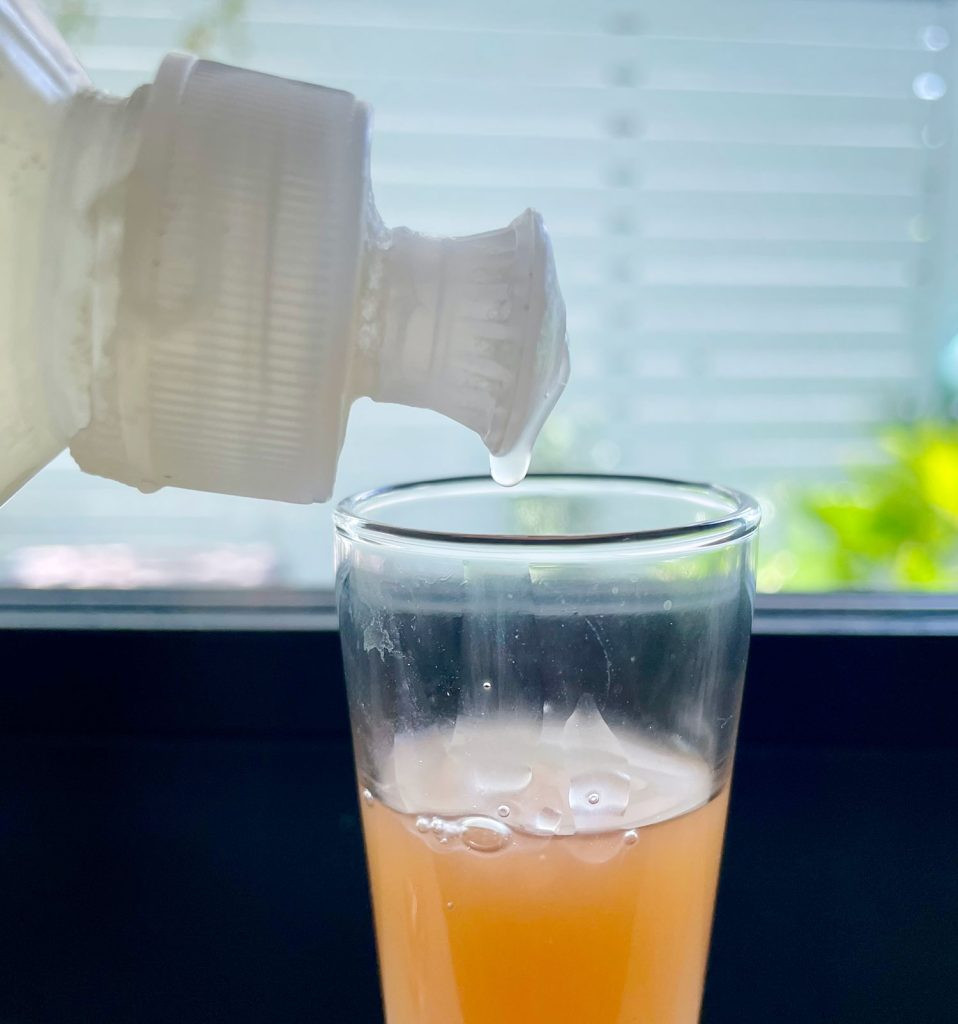 Dripping Dish Soap Into Apple Cider Vinegar For DIY Fruit Fly Trap
Dripping Dish Soap Into Apple Cider Vinegar For DIY Fruit Fly Trap
Alt text: Dish soap being drizzled into apple cider vinegar in a bowl, preparing a simple and effective dish soap fruit fly trap solution.
Supplies needed:
- Small container, bowl, or dish
- Dish soap
- Apple cider vinegar (ACV)
Instructions:
- Put out some apple cider vinegar. Pour apple cider vinegar into the bottom of a small container, bowl, or dish. The scent will attract the fruit flies.
- Add dish soap & mix. Add a few drops of dish soap to the apple cider vinegar and gently mix. The soap breaks the surface tension of the liquid. Fruit flies attracted to the scent will land on the surface, become trapped in the soapy mixture, and sink.
This technique can also be enhanced by combining it with the plastic wrap or funnel trap methods. Simply add a few drops of dish soap to the apple cider vinegar before covering the container. This adds another trapping mechanism to increase effectiveness.
#4: Rotting Fruit Trap
For this method, instead of apple cider vinegar, we leverage what fruit flies love most: actual rotting fruit!
Supplies needed:
- Small glass jar, cup, or container
- Plastic wrap or paper funnel (depending on chosen trap mechanism)
- Small piece of ripe or overripe fruit (banana peel, apple slice, etc.)
To create a rotting fruit trap, simply replace the apple cider vinegar with a piece of banana peel, apple slice, or peach in either the Plastic Wrap Trap or Funnel Trap setup. You can also add a fruit scrap in addition to apple cider vinegar for enhanced attraction. Be mindful that fruit scraps need to be replaced every day or two to prevent unpleasant odors in your kitchen.
Finding the Best Lure: Banana Peel vs. Apple Cider Vinegar vs. Strawberry
To determine the most effective lure, I conducted a side-by-side comparison of different attractants. The four traps tested were:
- Plastic Wrap Trap with banana peel
- Funnel Trap with ACV + banana peel
- Plastic Wrap Trap with ACV + dish soap
- Dish Soap Trap with ACV
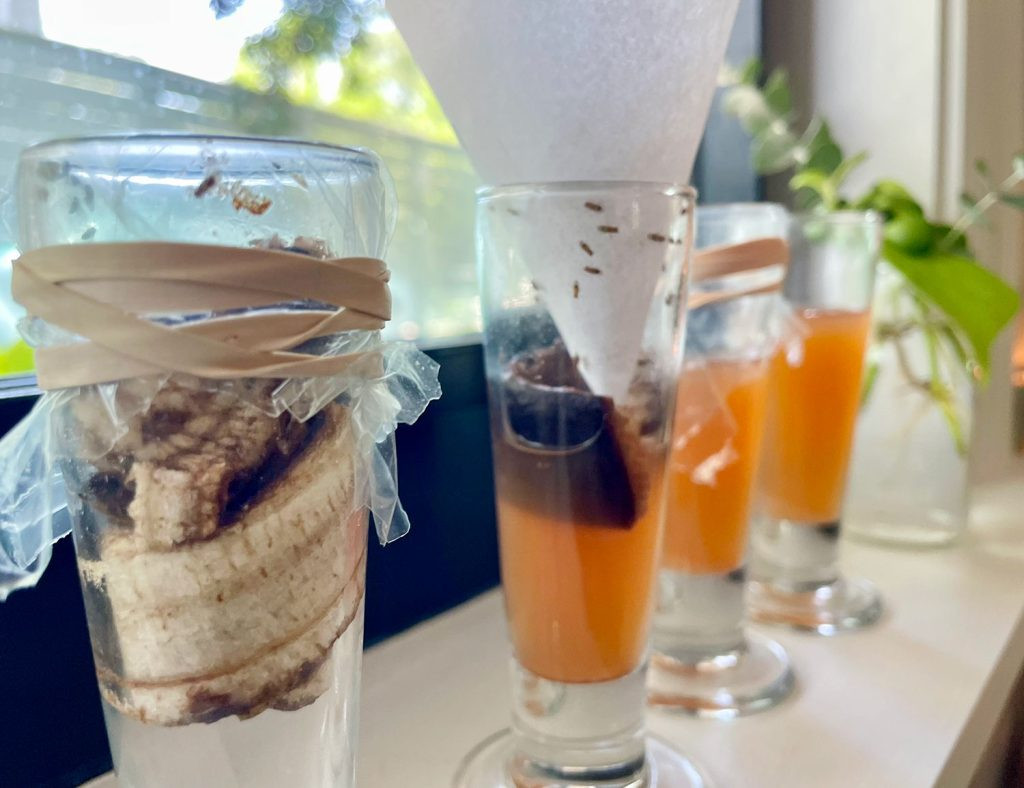 4 DIY Fruit Fly Traps Close Up
4 DIY Fruit Fly Traps Close Up
Alt text: A lineup of four different DIY fruit fly traps: plastic wrap with banana peel, funnel with ACV and banana, plastic wrap with ACV and soap, and dish soap with ACV, testing various lures and trap designs.
The results clearly indicated that the lure was more critical than the trap type. Traps baited with banana peel significantly outperformed those using only apple cider vinegar. While both plastic wrap traps were nearly identical in design, the one with banana peel captured dramatically more fruit flies than the ACV and soap trap. This suggests that while apple cider vinegar is effective, fresh fruit is even more enticing to fruit flies, especially when real fruit is present.
Therefore, regardless of the trap you choose, adding a fruit scrap is highly recommended! While both trap types worked well with fruit, the plastic wrap trap had a slight edge in practicality due to its ease of assembly and stability. The funnel trap was accidentally knocked over once, releasing some captured flies back into the kitchen – a minor mishap but worth noting.
Further experimentation focused on identifying the best type of fruit bait. Using plastic wrap traps, I tested banana peel, apple slices, and strawberry side-by-side for 24 hours.
While the banana peel initially seemed promising due to its stronger, riper scent, the strawberry ultimately proved to be the most effective lure. The banana peel still attracted a good number of flies, but as the strawberry ripened further, it became increasingly irresistible to fruit flies. Interestingly, the apple slices failed to attract any flies at all in this test.
Store-Bought Fruit Fly Traps: Are They Worth It?
If DIY methods aren’t working for you, or if you prefer a ready-made solution, store-bought fruit fly traps are readily available. These traps have generally positive reviews and are typically priced under $20. They may be a worthwhile option if you’re dealing with multiple types of flying insects or prefer a more discreet trap design.
 Collage of Storebought Fruit Fly Traps
Collage of Storebought Fruit Fly Traps
Alt text: A collage showcasing various store-bought fruit fly traps available for purchase, offering an alternative to homemade solutions.
During my testing, I also purchased Terro Fruit Fly Traps to compare their performance against homemade traps. I placed a Terro trap next to banana and strawberry-baited plastic wrap traps for 24 hours.
Again, the homemade strawberry trap captured the most flies, closely followed by the banana peel trap. The store-bought Terro trap caught only a single fruit fly in this initial 24-hour period. HOWEVER…
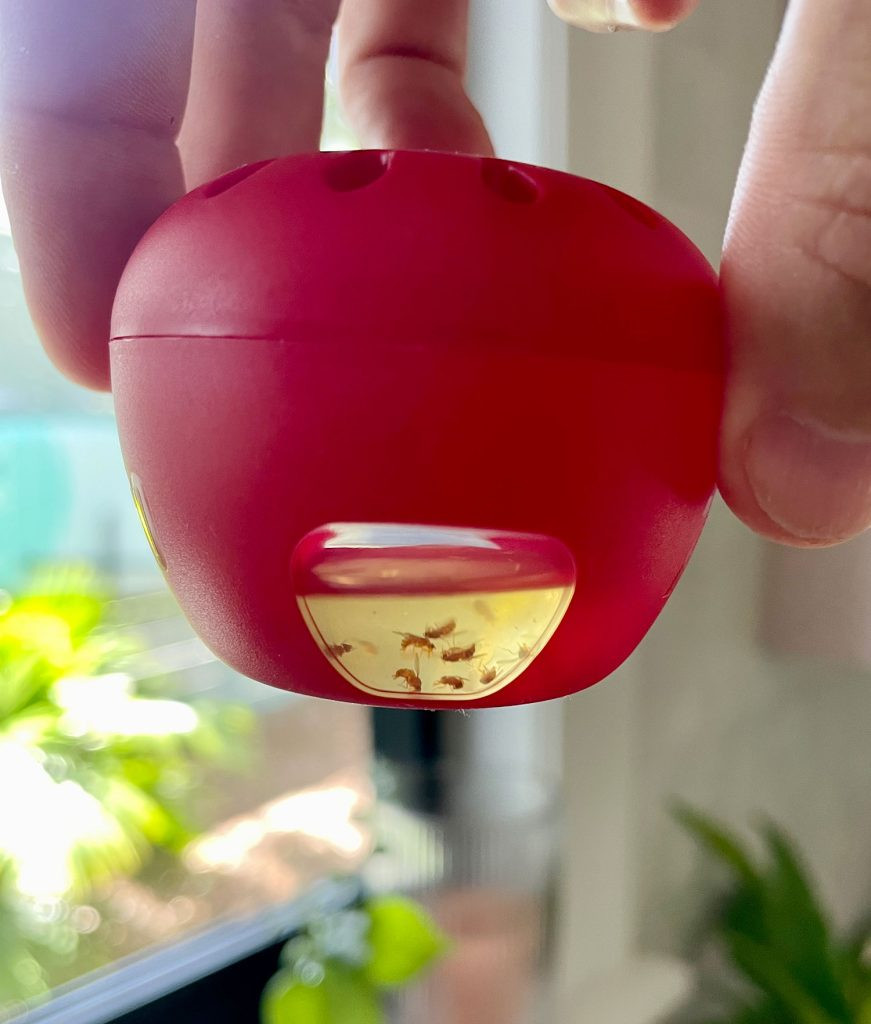 Terro Fruit Fly Trap With Dead Fruit Flies Visible
Terro Fruit Fly Trap With Dead Fruit Flies Visible
Alt text: A Terro brand store-bought fruit fly trap filled with dead fruit flies, demonstrating its effectiveness over a longer period.
To get a clearer picture, I removed the DIY traps and left the Terro trap in place for another 24 hours. Over this extended period, the Terro trap successfully captured a significant number of fruit flies, as shown in the image above. So, store-bought traps do work, but they are generally not as fast-acting or immediately effective as homemade traps, especially those baited with fresh fruit.
Verdict? Store-bought traps are a good option if you desire a more subtle appearance, especially for long-term placement. However, for rapid and highly effective fruit fly elimination, homemade traps, particularly those using fruit lures, are the superior choice.
How To Prevent Fruit Flies
While effectively trapping fruit flies is relatively straightforward, preventing them from infesting your home in the first place is the ideal scenario. Here are simple preventative measures to keep fruit flies away:
- Clean kitchen surfaces regularly. Wipe down counters, stovetops, tables, and any surfaces prone to food residue or spills. Fruit flies are particularly drawn to fruit, sugary liquids, and alcohol, so prompt cleanup is key.
- Take out your trash frequently. Food scraps left in indoor garbage cans, especially overnight, can quickly become a breeding ground for fruit flies.
- Dispose of overripe fruit promptly. Regularly check your fruit bowl and discard any browning or overly ripe fruits before they become a problem.
- Wash your fruit as soon as you bring it home. Washing produce immediately after purchase can remove any fruit fly eggs or larvae that may be present (except for berries, which can spoil faster if washed before storage).
- Store produce in the refrigerator when possible. Fruit flies struggle to thrive in cold environments. When in doubt, refrigerate fruits and vegetables, especially ripe ones.
- Clean your sink drain regularly. Food particles accumulating in your sink drain can attract fruit flies. Use your garbage disposal regularly, and consider flushing drains with hot water and a cleaning solution periodically.
Finally, remember not to panic when you first notice fruit flies. While it’s important to act quickly to prevent a full-blown infestation, the solutions outlined in this guide are easy, effective, and fast-acting. You might even find a bit of fun in experimenting and becoming your own “fruit fly scientist” in the process!
